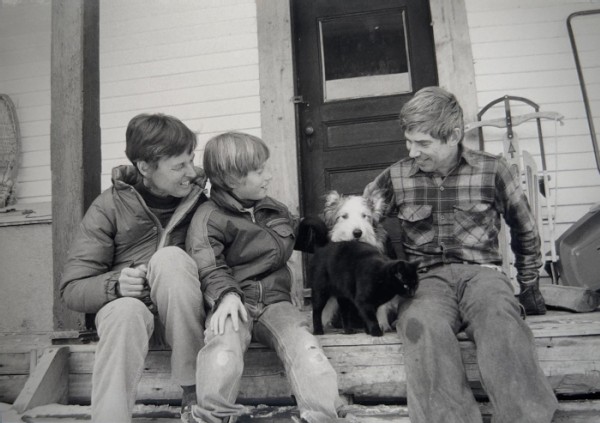About 20 years ago, when my wife, Rita, and I were still renovating our Maine farmhouse, we did much of our refurbishing with materials scrounged from old buildings that were falling to the wrecker. So it is that our house is now clad in clapboards I carefully peeled off the doomed corn cannery in Farmington, and the door to our living room is a castoff from Grant’s Kennebago Camps, which were undergoing some major remodeling at that time.
I confess to an infatuation with that door. That it came from Grant’s – one of the oldest, most revered trout-fishing camps in the Rangeley Lakes region, in all of Maine, and indeed in the entire United States – was, of course, enough to give it the status of an icon in any fly fisherman’s eyes. The door’s outward aspect, though, could hardly stir the heart. The door was painted a dull gray and had stenciled on it in black paint, at about eye height, the number 8. Dull gray was not the color either Rita or I would have chosen for our living room door, but our tastes at the time ran to the funky, and it seemed sacrilegious to alter a relic from Grant’s, an act as blasphemous, I thought, as using splinters of the True Cross for kindling.
Soon after the door was installed, the latch mechanism in it broke, leaving the knob to spin ineffectually in the hand and the door impossible to open unless we resorted to the thief ’s trick of inserting a putty knife (we didn’t even own a credit card) to push back the bolt. I removed the latch and never replaced it. Two generations of dogs and cats have rejoiced in having one door in the house they could open with a nudge.
But after 20 years of noses, paws, and human hands, the gray of our door had progressed from solemn to downright dingy. Cleanliness now seemed preferable to funkiness, and with time feeling more precious to us than money, we delegated the refinishing of the door to our friend Carol.
She laid the door over two sawhorses in the woodshed and attacked the gray paint with Zip-Strip. I was outside, scything down the meadowsweet, dogbane, and raspberries that seemed determined every summer to reclaim our yard and garden, when Carol called out. “Bob, I think you’ll be interested in this,” she said. “Come see.”
Carol’s scraper had peeled away the chemical muck to reveal the muted, mellow grain of poplar, which at first glance was all I noticed. But on second glance I saw the pencil outline of a fish on the center rail of the door. The tail of the fish was square – a brook trout. The rail in the door measures 21 inches long by seven inches wide, and the outline of the fish filled it completely. What would a deep-bellied squaretail that long weigh? Five, six, eight pounds? Did it matter? Even in its bare outline it was beautiful. It was magnificent.
On the right-hand stile was more: a drawing of a man standing waist-deep in the water, fly rod in hand, the rod arched, the line taut. And under this drawing were some barely decipherable names and dates:
Thos. G. Sandland
N. Auburn, Mass.
May 1, 1879
May 4, 1880
A. Atwood
June 7, 1878
J. A. Haskell
Mrs. J. A. Haskell
July 18-25, ’78
William S. Barret
Aug. 17, 1879
I stood there marveling at this piece of history I’d been living with for the past 20 years but was seeing now for the first time. I realized that our nondescript gray door had to have seen service in the Kennebago Lake House, which was built in 1871 and didn’t come under Ed Grant’s management until 1904. I was looking at a pre-Ed Grant trout, a trout from a mythic past before the name “Grant’s Kennebago Camps” even existed. I felt like Schliemann excavating Troy.
Who, if any, of the five people whose names I was reading had caught the fish? I was rooting for Mrs. J. A. Haskell, whom I fantasized as a lean, tough woman of about 35 with green eyes, good cheekbones, and a delicate touch with a fly rod.
I was also reveling in the prospect of having this treasure preserved in our living room under a fresh coat of varnish. This ghost from the past gave me more pleasure than any taxidermied monster mounted on a board ever could. But even in the few seconds it took for these thoughts to spin through my head, I noticed my specter fish becoming more spectral. The remaining Zip-Strip was eating away at him, at the angler with the tight line, at Mrs. J. A. Haskell.
“Oh, my God,” I said to Carol. “We’re losing him. Get the net. How do you stop this stuff?”
Carol mopped up what stripper she could with clean rags. I ran into the house for some water. We flushed the afflicted area. We wiped it clean. We flushed and wiped again and still again. In vain. The paint remover had penetrated too far to be reversed. It had done its work well. The fish was gone without a trace. So was Mrs. J. A. Haskell, the most ethereal crush of my entire crush-filled life.
My Kennebago camp-door trout, for as long as it lasted, was a pentimento. Pentimenti are what art historians call the sketches that an artist paints over that resurface in an old oil painting if the covering pigments fade. El Greco’s Laocoon in the National Gallery sports a disembodied head that the master painted over and put on a full-length figure farther to the left. Rembrandt’s Flora in the Metropolitan wears a hat with two brims.
Scholars used to have to wait until time (or a restorer’s overly zealous cleaning) brought these ghost images to light. Today, with X-radiography and infrared reflectography, they don’t have to wait. With Superman’s X-ray vision they can peer through a painting’s surface and study the creative process from under-drawing to ground preparation to floating heads and duplicate hat brims.
On our art we had used Zip-Strip, a far cruder tool, which, in practically the same moment, let a wondrous beast rise into our present, then sink back into the depths of the past. In practically the same moment, we were exultant and downcast; we celebrated and mourned.
Now, whenever I sit in my living room and look at that poplar door, beautiful for its color and grain but minus its fish, I muse on images captured and lost. I delight in the photographs we have that recall what Rita, my only permanent crush, looked like 25 years ago – how she wore her hair, the big wool sweater she had then that is no more. I rejoice in the pictures of our son, Greg, when he was a week old, and a year, and five years, and ten, and 12, and 20. I ache for the pictures neither I nor anyone else took: Rita in her stunning black cocktail dress that also is no more; Greg at seven sliding down a steep, narrow road with all the unselfconscious skill and confidence of the invulnerable, invincible young. The pentimenti of memory rise to the surface, swirl there momentarily, and fade again. Even the images we think we have captured on film or in oil or watercolors are in fact not much more than a fading pencil outline of the living creature, the living moment. Carpe diem. Seize the day.



